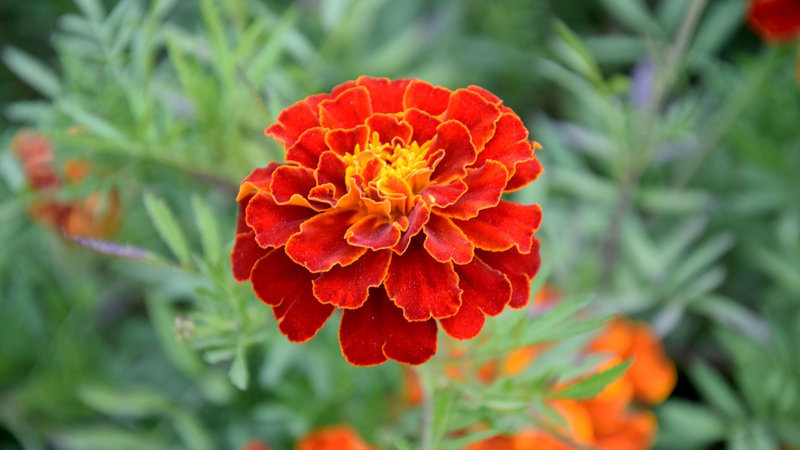Top 10 Benefits & Uses Of Marigold Leaves For Health
Marigold is a bright-colored summer flower, which is also known as Calendula. Marigolds are versatile plant, that comes in a variety of colors, bloom sizes, and height.

It is most commonly found near ponds, shores, quiet waters, springs, ditches, streams, wet meadows, wetlands, and sometimes even underwater.
Marigold is an herb that is believed to be one of the earliest cultivated flowers. It has been used for several ailments due to its medicinal properties. Ancient Greeks used marigolds for various purposes such as creating makeup, for dye both food and clothing.
Description
- Plant: Marigold is a short-lived sweet-smelling perennial plant, that grows up to 80 cm tall, with infrequently branched.
- Leaves: The leaves of the Marigold are oblong-lanceolate hairy on both sides and are about 5–17 cm long.
- Flowers: It has vibrant golden yellow flowers, consisting of a thick head or flowerbed which is 4–7 cm diameter encircled by two rows of hairy bracts. The Marigold flowers may appear all year long where environments are suitable.
- English names: It is known by various names such as Scottish Marigold, English Marigold, Garden Marigold, Ruddles, and Common Marigold.
Marigold is absolutely an amazing medicinal plant that has forged its way into Egyptian, Indian, Greek, and Roman medicine as well as into the herbal healing arenas of the Europeans.
Health Benefits of Marigold Leaves
The most important element for which Marigold is known for its antioxidant properties. An antioxidant is a property that is known to be capable of fighting the damage that led to free radicals.
In today’s by-products of environmental circumstances such as pollution, cigarette smoke, etc., antioxidant is essential. These antioxidants help to lower the risk of cancers, heart ailments and even protect the eyes from macular deterioration and cataracts.
Besides this, Marigold (Calendula officinalis) is also helpful in dealing with conditions such as rashes, allergies, dermatitis, eczema, swelling, pain, redness caused by muscle cramps or sprains or muscular injuries, itchiness caused by conjunctivitis, eye inflammation, and fungal infections such as eczema and athlete’s foot. below are some more marigold plant benefits.
1. Eye Infections
Marigold is among the several herbs that are used traditionally to treat eye inflammations and conjunctivitis it is also helpful to treat redness of eye infections and to reduce the swelling. It is also believed that Marigold may have some anti-spasmodic action, which has been used to relieve menstrual cramps.
2. Protection Against Cancer
A recent study by the Fedkovich Chernivtsi State University of Ukraine on Marigold shows that it has anti-cancer properties.
In conjunction with other herbs such as Scorzonera humilis L, Aconitum moldavicum, and Echinacea purpurea, Marigold has shown evidence of success in treating certain cancers.
3. Anti-Oxidants
Marigold has been medicinally used around the world for centuries. It has been traditionally used to cure eczema, blepharitis, conjunctivitis, warts, and minor injuries such as wounds, sprain burns, and cuts. Insect bites and bruises and minor burns, including sunburns.
It has also been used to treat coughs, cramps, and even snake bites. Due to the high content of flavonoids, Marigold acts as an antioxidant in the body. It protects our body cells from damage caused due to a chemical process called oxidation. Oxidation generates oxygen-free radicals and natural chemicals that suppress immune function.
4. Anti-Septic
A recent study on animal studies shows that Marigold contains flavonoids, which speed up wound healing by increasing blood flow to the affected area and rapidly increasing the production of collagen proteins.
Marigold also acts as an antiseptic and has anti-inflammatory effects due to its flavonoid content. In mouthwashes and gargles, Marigold helps to soothe a sore throat or mouth tissue; moreover has been used to treat hemorrhoids.
5. Best for Ulcers
Marigold leaves tea or infusion can be made for the healing of irritating, painful colitis, Stomach ulcers, and mouth ulcers. Marigold leaves are used for the healing of external ulcers, and wounds. The properties of Marigold leaves work by stimulating the lymphatic system and reducing swelling and cleansing toxins in the body.
It works as an anti-septic and improves blood circulation in the affected area. Although further research is needed late Some clinical studies (Chakurski 1981, Krivenko 1989)validate the treatment of stomach ulcers.
6. Treatment of Skin
Marigold leaves contain a property that is advantageous in reducing infection and promoting injury healing. It has been used in order to treat a variety of skin diseases.
Moreover, has been seen as productive in the treatment of skin ulcerations, eczema, juvenile acne, and dry phthiriasis. Improvement has been viewed within 3 to 4 days of treatment according to the study by (Universitatea de Medicina si Farmacie).
7. Fight Against Fungal Infections
Crushes of calendula flowers are useful for varicose veins. Results from current animal and laboratory reports show that calendula might also have some anti-infective properties, which can be against fungal infections and against viruses.
8. Fight Against Immunodeficiency Virus( HIV)
Marigold leaves have high-molecular-weight polysaccharides that motivate immune system activity (Wagner 1985) moreover; have been researched for immune system activity.
It was at first determined to have some possible therapeutic activity against the human immunodeficiency virus (HIV) extracts significantly inhibited HIV-1 in vitro and reduced HIV-1 reverse RNA polymerase in a dose- and time-dependent manner (Kalvatchev 1997).[2]
9. Good for Digestion
Calendula cream is good for acne and nappy rash. Marigold leaves are good for digestion, and symptoms of menopause also relieve colitis. An anti-fungal agent in Marigold leaves is used to treat Candida, ringworm, and athlete’s foot, and tincture applied to cold sores encourages healing.
10. Breast Cancer
A study of about 250 women who had been undergoing radiation therapy after surgery for breast cancer who used the calendula ointment reported less pain from the radiation.
Marigold ointment reduces the amount of skin irritation and anti-viral actions better than other commonly-used commercial preparation Investigations into anti-cancer continue.[1]
herbs or



























Ancient Greeks commonly marigolds to create makeup due to their strong coloring ability, besides this as a dye for both food and clothing. It has also been used as edible in cooking for centuries. In addition, marigold leaves were used for medicinal purposes, in fact, even today it is used.
Marigold leaves has a stronger aroma is it more active and are there different effects/benefits from the flowers?